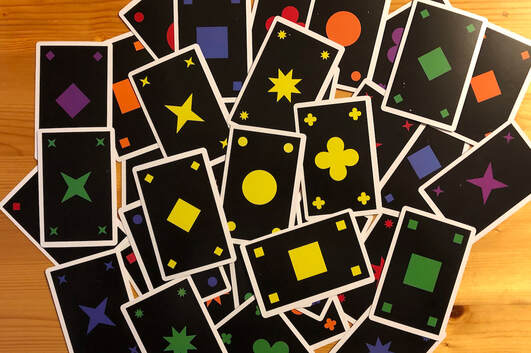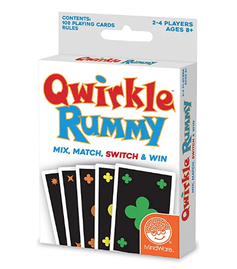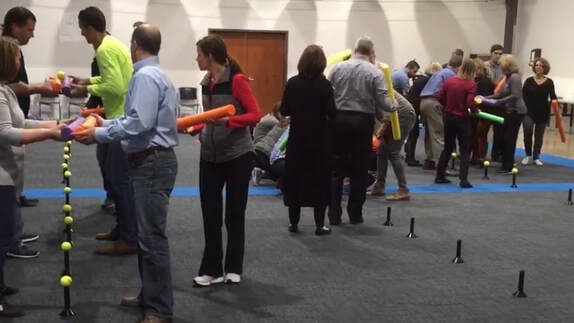|
It's so fun for me to find easy-to-use props for team building activities. Back in 2015 I shared the activity What's Missing using Qwirkle pieces - small wooded squares. You can get three sets of wooden pieces from a Qwirkle game, but it is a slight investment to buy the game. Well, those clever MindWare folks have a spin off - Qwirkle Rummy cards!! For us, it's a super-portable inexpensive prop for What's Missing.
I found my deck at Barnes & Noble for $6 (plus tax)! If you don't have a B&N near you, pick them up from their website for the same price - plus a little shipping HERE. And, same deal. There are three 'sets' of colorshape cards in a Qwirkle Rummy deck. So, you have a couple sets to give away. (FYI: At the time of this post, Amazon was selling the cards for about $12!?) |
Needs & Numbers: You will need one set of color shapes cards from the Qwirkle Rummy game - 36 cards: six different colors and six different shapes of each color (again, there are three of these 36-card sets in a Qwirkle Rummy deck). Plays well with 12-34 people.
Set Up: Place all 36 cards colorshape-side down on top of a table (or on the floor). You (the facilitator) pick up two cards off the table - be sure the group sees you pick up the cards, but make sure they don't see the colorshapes you have. NOTE: I like to make sure I have two cards of different shapes and colors, and, more often than not, I like to be holding one of the 8-pointed stars and a card that is purple or blue - I've found these cards often have the most ambiguity.
Once I have my two cards I ask each person in the group to pick up one card without letting anyone else see what colorshape they have. If there are cards still left on the table, I ask for volunteers to pick up another card. If there are still extra cards I ask for volunteers again to pick up another card. If all group members have the number of cards they want and there are still cards left on the table I will provide the 'Leftover' Rule (see below).
The Challenge: Once everyone has the card(s) they want to manage (this is a choice they can make) and they all understand they are not allowed to show their colorshape(s) to anyone in the group, the challenge is to find out the colorshape cards I am holding - the shape on each card and the color of the shape on each card.
When I facilitate this one, more often than not, I allow my group three attempts at the answer. And, when making an answer attempt, they must tell me the shape on both cards and the color of each shape. If the answer is incorrect, I simple say, "Incorrect." I don't tell them which one is incorrect. This adds a little more 'adventure' to the process. If their answer is correct, with a little flare, I reveal each card and we celebrate the effort before debriefing the learnings.
The One-Shot Challenge: I have used this process as well. I leave all 36 cards on the table and ask them to pick up cards (like explained above) until only two remain. (If there are more than two after everyone has the card(s) s/he wants, I ask someone to slide two cards off to one side of the table - these are the two they will need to discover. The group will use the Leftover Rule with the other cards left on the table.) When the group believes they have the answer we flip over one card at a time to see if they 'succeeded' or 'failed.' This process can be stressful but very appropriate for some groups.
Rules:
- Players are allowed to say anything they want about the colorshape on their card, but they can't show anyone what they have.
- Players are allowed to move around.
- Players may not give away any cards they are holding.
- Players are allowed to put a card they are holding back on the table.
- Players may not pick up a card from the table once the activity begins - when players start sharing information about their cards.
Leftover Rule:
- Every player can take one turn to pick up one card from the table, look at it - no more than 10 seconds - then place the card back on the table, colorshape down.
Variations:
- If you are playing with smaller groups (e.g., 12 participants) you can take out six cards - six of the same color or six of the same shape to keep the 'set' intact. If you need to take out more, the next removal would be five of the same shape or five of the same color. (The "set" will not remain intact taking out random pieces.)
- Don't allow the players to move around during the activity - they must remain in the place they are standing once the game begins.
Chris Cavert, Ed.D.









 RSS Feed
RSS Feed